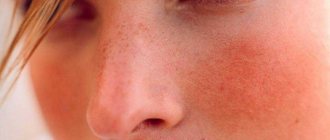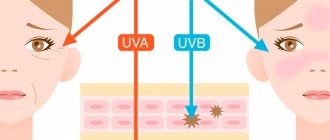Four skin types
In different sources you can find definitions such as “sensitive skin”, “acne-prone skin”, etc. All these are individual characteristics of the skin. In cosmetology, there are only four main types.
Acne-prone skin usually occurs in oily and combination skin types. Approximately 80% of adolescents suffer from it, which is associated with heredity and hormonal changes.
- Normal. This kind of skin is very rare, so its owners are simply lucky and fortunate! The skin is evenly supplied with blood, which is why it is pinkish. There is almost no irritation on it, it is elastic, does not flake, looks clean and fresh due to the optimal amount of lubrication and moisture. With proper care, normal skin will not develop wrinkles for a long time.
- Dry. It is distinguished by small pores and a dull, matte shade, low fat content. Without proper care, it peels off, cracks from lack of moisture, and can quickly become covered with wrinkles. The skin often feels tight, and irritation appears as a reaction to temperature changes, detergents, and some ointments and creams.
- Fat. The sebaceous glands work intensively, so the face shines. A large amount of fat protects against aging and wrinkles for a long time, but large, noticeable pores quickly become clogged, and the face may have an unclean appearance. This type of skin is prone to acne and pimples.
- Combined. It has a fairly healthy appearance, but can be unevenly colored - reddish in places, white in others. Usually dry around the eyes, temples and cheeks, oily in the T-zone (forehead, nose, chin). Oily skin often becomes combination in women after 35 years. With proper care, the face looks young for a long time, wrinkles do not appear soon.
To properly care for your face, determine your skin type
Classification of skin types according to Leslie Baumann
The basis of the classification is the distribution of skin according to 4 parameters:
dry - D or oily - O sensitive - S or resistant - R pigmented - P or nonpigmented - N smooth / (tight) - T or wrinkled ( wrinkled - W
By combining these parameters, you can find the abbreviation in the following table:
How to determine your skin type
Do a simple test to determine your skin type. Clean your face thoroughly, but do not apply cream to your skin! Wait 2-3 hours, then stand in front of a mirror in a well-lit place and carefully examine yourself. First, pat your face dry with a paper towel. If paper:
- clear - you have dry or normal skin
- with oil stains – greasy
- with oily spots in the T-zone – combination
Try to answer a series of questions. Your skin is dry if:
- it is matte, with roughness
- your eyes have fine wrinkles and you are over 25
- redness appears in the wind, frost, or sun
- you almost never encountered acne
- pores are almost invisible
Your skin is oily if:
- have acne
- pimples appear frequently
- faded color
- seems loose, pores are clearly visible
- redness and irritation are rare
Your skin is combination if:
- seems oilier in summer than in cold weather
- enlarged pores visible in the middle of the face
- If acne appears, it is usually in the T-zone
- on the cheeks, pores are less noticeable, the skin here is more even
- In winter, the forehead and cheeks become rough
If you did not answer yes to a number of these questions, your skin is even and smooth, pink, and looks healthy - congratulations, you have normal skin! However, this does not mean that you do not need to take care of your face.
Any skin needs daily cleansing, moisturizing, and nutrition. You should always have on hand at least foam for washing, cleansing tonic lotions, cream for normal skin, natural ingredients for making nourishing masks. But if caring for this type of skin does not cause difficulties, in other cases it is important to know some tricks of cosmetic procedures.
Choose a face cream according to your skin type
Features of different types
Facial skin types influence not only the choice of care and decorative products, but also their lifestyle. Even the most problematic skin is not hopeless. Proper skin care, nutritional adjustments and additional procedures can completely transform it.
Normal
As a rule, normal skin occurs in a healthy and young person. It has a beautiful natural shine, normal sebum secretion and elasticity. You can identify such facial skin by touch. It is elastic, smooth and silky. There are no significant wrinkles or enlarged pores. Normal skin tolerates washing with cold or hot water, as well as adverse weather conditions.
Many women mistakenly believe that normal skin does not require special care. However, if you do not do preventive procedures at home and in the salon, it will inevitably lose its excellent qualities, and it will take a lot of time and effort to restore them.
Fat
In appearance, oily skin is dense and thick, has an oily sheen and enlarged pores, which are often clogged. This is how comedones and pimples form. Upon closer inspection, some areas of the face resemble lemon peel.
The reasons for increased fat content of the skin are eating large amounts of fats and simple carbohydrates, alcohol and spices, disruption of the body’s hormonal levels and digestive function. Incorrect care can also make your skin oily. Thick creams with a greasy texture or frequent overdrying with alcohol-containing lotions can change its water-fat balance.
Dermatologists note that a person can have two completely different types of oily skin: hydrated and dehydrated. Finding out the exact type is important as care for them varies greatly.
- Moisturized problem skin becomes very shiny and looks unsightly. The pores are enlarged, which is why it is constantly attacked by microbes. As a result, the sebaceous glands become inflamed and acne appears.
- Dehydrated, oily skin often appears lifeless and flaky. Her sebaceous secretions are too thick and dense to leave the pores on their own and come to the surface. Because of this, closed subcutaneous comedones are formed, which require care with the help of special cosmetic products (soft scrubs and acids). It is quite difficult to find a solution to such a problem on your own. It is best to contact a dermatologist and undergo a full course of the procedures that he recommends.
There is no special test to accurately determine the subtype of oily skin type. Long-term monitoring of her condition will help you. Try different products for six months and note how your face reacts to them. If you have problem skin, finding your skin care routine is not so easy. But all the efforts will more than pay off with the first long-awaited results.
Dry
Externally, dry skin is thin and matte. Improper care and bad weather quickly worsen her condition. It becomes covered with small wrinkles, begins to peel and turn red. A not entirely optimal balance of moisture and fat makes it rough and rough to the touch.
Dry skin types look very beautiful when young. A healthy body copes well with its hydration in any conditions. But with age, inappropriate care and poor nutrition begin to affect its elasticity.
Dryness is influenced by both internal and external factors. Internal ones include disturbances in the functioning of the nervous system, old age, decline in the functioning of the reproductive system, as well as insufficient or unhealthy nutrition. Externally, the condition of the face and its dryness can be affected by frequent use of alkaline soap, alcohol-containing products and prolonged exposure to hot air. It is important to find out these reasons in a timely manner and, if possible, adjust your lifestyle and skin care.
Combined
Combination skin causes many problems. Various combinations (dry cheeks and oily T-zone, dry forehead and problematic nose skin) require a special method of cleansing, toning and moisturizing.
Skin care should be tailored to suit your needs. This does not mean that you will need to buy different products for each area. All you need is to find a neutral day cream and a multifunctional night cream. Remember that the face is constantly changing and determining your skin type is your constant task. Do the test regularly and as soon as you feel changes, supplement your care with a new product.
Now you know how to determine your skin type. Using this information, you will stop being disappointed in the cosmetic products you purchased and will easily select the ideal care for her.
Rules for caring for dry skin
- Do not wash with tap water and soap - this will cause additional dryness, irritation, and a feeling of tightness. It is necessary to cleanse the skin morning and evening with foams and mousses designed specifically for dry skin. You need to remove makeup with milk that contains unsaturated fats or waxes, vegetable oils.
- Use facial moisturizers. They may contain sugar, urea, glycerin. Dry skin really needs provitamin B, amino acids such as serum albumin. Toners will moisturize your face very well, but not alcohol lotions!
- A face with a tight effect needs protection. It is recommended to use day cream with natural oils, linoleic and linolenic acids. These healing components help dry skin restore its lipid barrier and not become tight. It’s good if the daytime face cream contains UV filters, vitamins E and C, and collagen. Good natural ingredients include extracts of grape seeds, algae, honey, and olive oil.
- Nourishing night cream for dry skin will help cells regenerate. It should be applied to cleansed skin in a thick layer, after half an hour, remove excess with a napkin or clean cloth. The care product for dry skin may contain elastin, whey, and collagen.
- It is important to do nourishing masks regularly - 1-2 times a week in courses of 10-15 procedures, since their effect appears quickly, but it is short-lived.
Mask for dry skin
Boil oatmeal in milk, mix with extra virgin olive oil and squeeze out a couple of vitamin E capsules. Apply the mixture to a well-cleansed face, avoiding the area around the eyes. After 15 minutes, rinse off the mask with warm water.
What's important at age 30
Young beauties think least of all about wrinkles and crow's feet around the eyes. The greater their disappointment and even fear when one morning they discover wrinkles in the skin around the eyes or between the eyebrows. What should we not forget at this age? About high-quality hydration both inside and outside.
- The total volume of liquid drunk (except coffee, tea, soups) should be 30 ml of water per kilogram of body. In general, approximately 1.5–2 liters.
- It is necessary to use moisturizing creams and masks.
- Be sure to use cosmetics with SPF.
At this age, you already begin to understand that sleepless nights are not in vain - after all, after them, traces of fatigue are visible: dull skin color, puffiness under the eyes, dark circles.
How to remove bags under the eyes: massage, gymnastics, cosmetics
Expression wrinkles gradually transform into permanent ones. Puffiness under the eyes gives way to bags and dark circles, which tend to form not only after a sleepless night, but also for no apparent reason.
If it is not possible to correct the changes with the help of a cosmetologist, it makes sense to take a closer look at care products that are more powerful in their impact. What to look for in the composition?
- Antioxidants.
- Vitamins.
- Peptides.
- Retinol.
- Sun filters.
This is a very responsible age. Today, 50-year-old women can give young women a head start. And not by chance. Skin care, cosmetic procedures, adherence to the principles of a healthy lifestyle - all together gives an amazing result: a youthful appearance, a slender body, elastic skin, sparkle in the eyes.
Obviously, time affects the body - with the onset of maturity, the skin becomes drier and its needs change. In short, the cream that you liked at 20 will no longer cope with its task at 40.
We suggest you familiarize yourself with what a chicken butt wart looks like and how to treat it?
Up to 25 years
Combination skin still needs high-quality moisturizing and non-aggressive cleansing. However, due to its characteristics, it can be prone to acne. It is quite possible to prevent and reduce pimples by using cosmetics with acids and cleansing masks.
After 25 years
During this period, it will not hurt to add products with antioxidants to your care routine to protect against aggressive factors and prevent aging. Pay special attention to hydration - look for formulas with hyaluronic acid.
After 35 years
The first signs of aging appear, associated with a decrease in the production of the body’s own hyaluronic acid. To ensure that this process remains without consequences, include an intense moisturizing cream in your care, and not only in winter.
Up to 25 years
Until the age of twenty-five, the dermis needs to be moisturized - it is necessary to use products with a pronounced moisturizing effect and intended for this age.
After 25 years
After twenty-five years, the aging process begins in the body and the skin begins to gradually lose moisture - hydration and rejuvenation are required. You should opt for products with hyaluronic acid in the component composition.
After 30 years
From the age of thirty, skincare cosmetics should have a rejuvenating effect; it is recommended to combine care for normal skin with facial gymnastics to maintain the oval frame.
After 40
After forty, you can maintain skin condition with products intended for this age group in combination with professional methods available in beauty salons.
Rules for caring for oily skin
- Wash your face with cool water twice a day and wipe with ice cubes. It is better if it is frozen herbal decoctions - chamomile, nettle. Cold tones oily skin and tightens pores, while preserving and “freezing” your beauty, while hot water promotes the active secretion of fat.
- To improve blood circulation in the facial skin and optimally cleanse acne-prone or pimply skin, take steam baths once a week. Throw a handful of chamomile flowers into boiling water, cover with a towel and hold your face over the container for 10 minutes. Don't get burned by hot steam! You can apply a mask to steamed skin, the components of which will have a more active effect on open, clean pores. Grated raw potatoes will give the skin a matte and velvety feel. Apply it on your face, avoiding the eye area, keep it on for 15 minutes and rinse off.
- Weekly at night you should use a scrub for oily skin, peeling, which will cleanse enlarged pores and prevent the appearance of acne and skin diseases. Scrub masks can be made from white, blue, black or brown clay: mix with water to a creamy paste, apply to the face, and after drying, rinse with warm water.
Face cream must match your skin type! Products containing artificial materials such as petroleum jelly, mineral oils, and ceresin are not recommended. They clog pores.
Mask for oily skin
A mask made from egg white and a teaspoon of freshly squeezed lemon juice perfectly mattifies the face and tightens pores. Lubricate the area around the eyes with cream. Mix the ingredients of the mask thoroughly, apply an even layer to the skin and after 10 minutes, rinse with cool water.
For face masks to be effective, they should be done regularly.
What determines facial skin type
The appearance of the skin is influenced primarily by genetic and hereditary factors, but over time it can change for several reasons:
- With hormonal changes and changes during puberty, pregnancy, menopause.
- In case of a sudden climate change, moving to a new place of residence in another country.
- Under the influence of bad habits, poor nutrition.
- With stress, which affects not only nerve cells, but the entire body as a whole.
Rules for caring for combination skin
- Mixed skin types are capricious and may require different care in warm and cold seasons. So, in the summer heat you will need to care for your face like an oily one, in winter - like a dry one. In warm weather, you will need to wash your face more often with cool water, use peeling and tightening protein or clay masks once a week. During the cold season, use scrubs once every 2 weeks, use a face cream with a richer texture.
- Choose a water-based face cream, in the summer - with a level of ultraviolet protection of at least six factors. All care products for combination skin should be hypoallergenic.
- Buy special tonic lotions for combination skin, or take care of dry and oily areas of the face separately. So, during your morning wash, cleanse your face with foam for normal skin, wipe the T-zone with a swab dipped in a warm decoction of chamomile or nettle, and treat with a scrub 1-2 times a week.
If the packaging of the cream says “pH balanced”, the pH level is 5.5. It is comfortable for normal skin. pH 5-6 is suitable for dry skin, 3-5 for oily skin. Alkaline creams with a pH higher than 7 are not recommended for anyone.
Mask for combination skin
Lightly beat the yolk with a fork, mix with a teaspoon of cold-pressed olive oil and grated cucumber until a paste is obtained. Apply an even layer to clean facial skin, after 15 minutes, rinse with warm water and apply cream for combination skin.
Daily Skin Care Routine: A Step-by-Step Guide
Note: Regardless of your skin type, you cannot skip the three main steps - cleansing, toning and moisturizing (CTM procedure). Otherwise, you can experiment with any skin care product that suits you.
Treatment for normal skin
Normal skin is balanced and has no problems like other skin types. The goal of your skin care routine should be to not upset the balance.
Morning care for normal skin
Cleaning
Cleanse your skin with a gentle, sulfate-free cleanser. Sulfate-free cleansers won't dry out your skin and do a good job of getting rid of any excess oil or dirt that may have settled into your skin's pores.
Tonic
Avoid toners that contain alcohol. Not only are these products extremely harsh on your skin, but they also dehydrate your skin and cause dryness. Instead, use toners with natural ingredients such as rose water and any other hydrating ingredients such as hyaluronic acid.
Hydration
Using a moisturizer with SPF will help hydrate your skin while protecting it from the sun. Find one that has an SPF value of 30 or more. Also, choose products that are non-comedogenic and specifically formulated for the face.
Sunscreen
Although your moisturizer contains SPF, be sure to apply sunscreen. Go for a sunscreen that has at least an SPF 30 and a PA+ rating. This ensures that your skin is protected from both UVA and UVB rays.
Night care for normal complexion
Cleaning
Use the same cleanser you use in the morning. However, it is better if you cleanse twice. In other words, remove all the dirt, makeup and dust from your face with a cleansing oil and then use another cleanser to wash your face.
Tonic
Toner your face with the same toner you use for your morning routine.
Serum
Use an antioxidant-rich serum to provide extra nourishment to your skin. Check for ingredients such as algae extracts, resveratrol and vitamin C.
Eye cream
Apply an eye cream that is formulated for specific concerns, such as dark circles or puffy eyes. Choose the one that can solve your problem.
Hydration
Switch to a moisturizer with a creamy formula to provide deep nourishment to your normal facial skin.
We recommend reading
Uneven Skin Tone: Tips and Home Remedies to Even Out Skin Tone
Additional treatment for normal facial skin
You can exfoliate your skin with a glycolic acid serum. Glycolic acid is gentle on your skin and can penetrate deeply. It cleanses it of dead epithelial cells, resulting in your skin looking brighter and smoother.
Home Remedies to Try
You can also apply yogurt to your skin. Both internal consumption and topical application of yogurt are beneficial for the skin and help keep it healthy.
Treatment for oily skin
Oily skin has overactive glands that produce excess sebum. The goal of a skin care routine should be to minimize oil while maintaining hydration levels.
Morning care
Cleaning
It's important to invest in a cleansing face wash if you have oily skin. You can also look for oil-free cleansing gels or foams. Prefer sulfate-free products as they will control oiliness, reducing the risk of drying out your skin.
Cleaning
You can use a very gentle scrub to clean out your skin pores occasionally. Oily skin is prone to pimples, blackheads, and clogged skin pores, and cleansing ensures that your skin is properly cleansed. However, avoid using a hard scrubber. You can use gentle exfoliants three times a week.
Tonic
An alcohol-free toner with ingredients like sodium PCA, witch hazel, or geranium is the best way to combat oily facial skin. These astringent ingredients help cleanse the skin and unclog the skin's pores without damaging or dehydrating the skin.
Hydration
Contrary to popular belief, hydration is crucial even for oily skin types. Dehydrated skin can kick your oil glands into overdrive, leaving your skin in worse condition than before.
Look for oil-free moisturizers. Water-based, non-comedogenic lotions are usually a good option for oily complexions. These products feel the light on your skin, keep it hydrated and leave it with a matte finish. If you have very oily skin, you may choose to invest in a good moisturizing gel.
Sunscreen
Applying sunscreen may not seem appealing if you have oily skin. However, this is because you probably didn't use the right products. Sunscreens with zinc oxide can make a world of difference to your skin care regimen. These products leave your skin with a matte finish and also prevent acne breakouts.
Night care for oily skin
Cleaning
Use the same cleanser you use in the morning.
Tonic
Toner your face with the same toner you use for your morning routine.
Serum (AHA/BHA)
Oily skin usually has large pores and AHA/BHA serums help reduce the appearance of skin pores. If you have acne-prone skin, look for ingredients like tea tree oil and salicylic acid.
Serum (Retinol)
Use any serum with retinol. This serum is beneficial for oily skin as it helps minimize the appearance of pores with continued use.
Night cream
Ultimately, you can use a water-based, oil-free, non-comedogenic night cream to lock in all the facial skin care products you've applied. The water-based moisturizer is ideal for oily skin as it feels very lightweight.
Additional treatment
You can use facial oils and clay masks as complementary treatments to control oil and keep your skin healthy. Clay masks help absorb excess oil and keep your skin clear while the oils provide extra hydration.
Home Remedies to Try
You can use clay masks once or twice a week. Choose any clay-like mask or bentonite clay. Make a paste using water or rose water and apply it on your skin. You can also use lemon juice diluted with water on your skin from time to time. It contains vitamin C, which helps reduce UV-induced skin damage such as photoaging and dark spot/pigmentation problems.
Dry skin care procedure
A skin care routine for dry skin should focus on hydration.
Morning care for dry skin
Cleaning
Invest in a gentle cleanser that doesn't lather. It is gentle on your skin and gets rid of dirt without stripping it of moisture.
Tonic
Look for very gentle ingredients in your toner. Toners with ingredients like cucumber and aloe vera help cleanse your face while keeping it hydrated.
Serum
An antioxidant serum will help strengthen your skin's defenses. It also helps collagen breakdown. Look for ingredients like vitamins A, C, and E.
Hydration
Moisturizer gives your skin the hydration it needs. Look for a moisturizer that has a thick consistency and contains moisturizing ingredients such as dimethicone, ceramides, and glycerin. Also, make sure the formula is oil-free and non-comedogenic.
Sunscreen
Choose a sunscreen that has a serum formula. The rule of sun protection remains the same - choose a formula with a minimum SPF of 30 and a PA+ rating.
Night care for dry skin
Cleaning
Use the same cleanser you use in the morning.
Tonic
Toner your face with the same toner you use for your morning routine.
Serum
A retinol serum will clear your skin of dead epithelial cells, revealing a healthier layer of skin. This will also help prevent the formation of fine lines.
We recommend reading
Caring for dry skin at home
Eye cream
Since dry skin is prone to aging and fine lines, using an eye cream can keep your skin looking young and healthy for a long time. An eye cream that contains peptides can help boost collagen activity, improving skin cell turnover.
Hydration
Buy a good night cream with high moisturizing value. Moisturizers containing evening primrose oil, sweet almond oil, jojoba oil, cranberry oil, phospholipids, borage oil, or rose hip seed oil are good options as they act as natural lipids in your skin and strengthen its moisture barrier.
Additional treatment
Dry skin tends to flake, which can lead to a buildup of dead skin cells. Gentle exfoliation can help remove these dead skin cells and make your skin more receptive to the products you use. You can use face oil as an alternative to night cream if you have very dry skin. Leave the oil overnight. You can also use a hydrating sheet mask occasionally.
Home Remedies to Try
You can apply honey to your skin. Honey helps regulate skin pH and is an excellent emollient and moisturizer that keeps your skin hydrated. You can also apply aloe vera as it helps bind moisture to your skin and support collagen development for more youthful looking skin.
Treatment for combination skin
Combination skin is oily in some parts and dry in others. But that doesn't mean you have to follow two separate skin care routines. Instead, you must find a balance. This is why a skin care routine for combination skin can mimic steps from other routines.
Morning care for combination skin
Cleaning
Follow the instructions given for oily skin. If it's too drying for your skin, switch to a cleansing lotion that doesn't lather.
Tonic
Follow the instructions given for oily skin. You can also use a toner that contains witch hazel.
Serum
Moisturizing serum is the best choice for combination skin. Serums provide an extra dose of hydration, prevent tightness and prevent a feeling of heaviness. Choose a serum containing hyaluronic acid.
Hydration
While you don't need to use an oil-free moisturizer for combination skin, invest in a lightweight mattifying moisturizer that will control oiliness while keeping your skin hydrated.
Sunscreen
Sunscreen is a must for all skin types. Choose a sunscreen that has an SPF 30 and PA+ rating and gives a matte finish.
Night care for combination skin
Cleaning
Use the same cleanser you use in the morning.
Tonic
Toner your face with the same toner you use for your morning routine.
Serum AHA/BHA
Choose an AHA/BHA serum for your skin. AHA is extremely gentle on your skin, and BHA (like salicylic acid) exfoliates your skin and prevents acne.
Eye cream
You need to nourish the area under your eyes. If you have any specific problems such as puffy eyes and dark circles, choose an eye cream that addresses these problems.
Hydration
Moisturize your face with the same product you use in the morning.
Additional treatment
Just like for oily skin, you can only use clay masks on areas that are oily. You can also massage your face with facial oil occasionally. This keeps your skin hydrated without causing excessive oiliness.
Home Remedies to Try
For combination skin, it is best to use soothing ingredients such as yogurt and honey. These two ingredients ensure that your skin remains healthy and comfortable.
Care for sensitive skin
A skin care routine for sensitive skin should contain products that are non-irritating and specifically formulated for sensitive skin.
Morning care for sensitive skin
Cleaning
Use a gentle, sulfate-free, non-foaming cleansing lotion to wash your face in the morning. This will help remove dirt without irritating your skin.
Tonic
Avoid toners that contain alcohol. Invest in one that contains ingredients like green tea, white tea, chamomile, and beta-glucan, as they are anti-inflammatory and help strengthen your skin's immune system.
Facial spray
You can spray a moisturizing and gentle facial mist. This helps soothe your skin. Choose a spray that has a moisturizing formula.
Hydration
Fragrances and hypoallergenic are the way to go when you buy a moisturizer for sensitive skin. This will keep your skin hydrated without irritating it.
Sunscreen
Choose a sunscreen that contains zinc oxide. This ingredient is less likely to irritate your facial skin.
Night care for sensitive skin
Cleaning
Use the same cleanser you use in the morning.
Tonic
Use the same toner as in the morning.
Serum
Choose a serum that contains moisturizing and soothing ingredients. Choose one that is specially formulated for sensitive facial skin. Look for ingredients like hyaluronic acid and organic ingredients like chamomile and calendula oils.
Eye cream
When choosing eye creams, focus on soothing and hydrating ingredients such as vitamin E, chamomile and hyaluronic acid. Also, make sure the product is free of parabens and fragrances.
We recommend reading
10 Amazing Benefits of Oxygen for a Radiant Skin
Night gel
When choosing a night gel, go for a product that is non-irritating, fragrance-free and hypoallergenic.
Additional treatment
Sometimes you can use gel overnight masks. They keep the skin hydrated and feel very soothing on irritated facial skin. You can also try using lactic acid serum - it is not harsh and is suitable for sensitive facial skin.
Home Remedies to Try
The combination of honey and yogurt works well for sensitive facial skin. These ingredients do not irritate the skin and keep it healthy. You can also try using an oatmeal scrub. Oatmeal has anti-inflammatory properties that help soothe the skin.
A good skin care regimen is not about using too many products, but about using the right products in the right way. This is the easiest way to take care of your skin. However, if you have mature skin, you can follow the skin care routine for your skin type mentioned above, but use specific products formulated for mature skin.
Treatment for aging skin
Morning care for aging skin
Cleaning
Regardless of your skin type, you need to use a good quality cleanser every morning and evening. Mature skin needs more nourishment, so use a cream cleanser instead of a foaming cleanser. The cream cleanser helps retain moisture and maintain a fresh look.
Tonic
Avoid alcohol-based toners. Since mature skin loses moisture quickly, it is best to use a moisturizing toner. Use water-based toners that contain soothing ingredients such as chamomile and cucumber extracts, panthenol and vitamin B.
Serum
Lightweight, non-greasy and anti-aging serum is what your skin needs. Choose one that contains ingredients such as hyaluronic acid and vitamin C.
Hydration
The moisturizer that worked in your 20s won't work anymore. Use hydrating moisturizers that contain ingredients such as hyaluronic acid, aloe vera, glycerin. Choose one that is specifically formulated for mature skin, unscented and hypoallergenic.
Sunscreen
Mature facial skin needs general protection. Use a broad-spectrum sunscreen that protects your skin from both UVA and UVB rays. Choose one with a high SPF and PA+ rating and is water resistant.
Night care for aging skin
Cleaning
Use the same cleanser you used in the morning.
Tonic
Use the same toner as in the morning.
Serum
Use a serum that contains anti-aging ingredients like retinol, glycolic acid, hyaluronic acid, and vitamin C. Look for targeted serums that work on issues like fine lines, wrinkles, hyperpigmentation, and skin brightening.
Eye cream
Look for eye creams that contain anti-aging ingredients that keep skin hydrated, prevent puffiness, and minimize fine lines.
Hydration
Use the same moisturizer you use in your morning routine.
Additional treatment
Use a gentle scrubber or exfoliant to exfoliate your face once a week. You can also use a facial oil once or twice a week instead of moisturizer to keep your skin hydrated.
Home Remedies to Try
The goal of DIY remedies should be to soothe your facial skin and make it feel comfortable. You can apply ingredients like honey, yogurt, rose water or freshly brewed green tea once or twice a week.
No matter your skin type or age, there are a few rules to follow to maintain clear, glowing skin throughout your life. These are the basics of any skin care regimen that everyone should follow. Look.
Type Characteristics
- Normal
This skin type is one of the rarest. Definition: good stretch, smooth, tender, not greasy or dry. There are no enlarged pores, the presence of rashes is unlikely. Positive reaction to various weather conditions and exposure to water.
- Fatty
Many ladies have this exact type. The active action of the sebaceous glands leads to enlarged pores and rashes on the face. Oily skin is shiny, rough, elastic, often with acne or pimples.
- Dry
Inherent in fair-haired and red-haired girls. The skin is thin, tight, and easily irritated. Reacts negatively to climate change and abuse of cosmetics, cracking and flaking.
- Combined
Mixed (more precisely, combined type) occurs quite often. Usually there is an oily sheen on the chin and forehead area, and soft and thin folds that stretch well on the cheeks. The combined type is characterized by rare formations of wrinkles on the face.
- Sensitive
Unfortunately, this type reacts to the slightest changes: the use of cosmetics and medications, temperature changes, health status. Prone to rashes, redness, itching.











